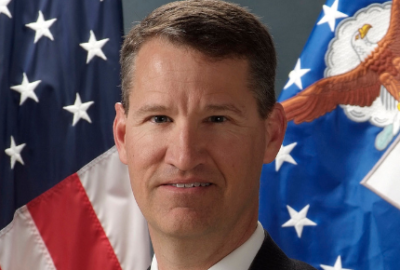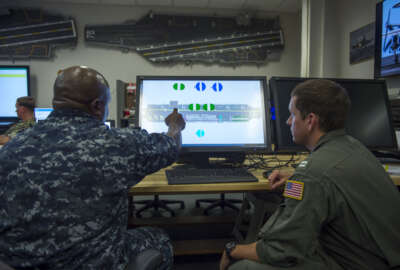
Air Force outlines goals to change business processes over next 2 years
The Air Force is aligning its business practices with the National Defense Strategy to stay ahead of near-peer competitors over the next two years.
The Air Force released a sweeping new business strategy Monday, saying it aims to align the service with the Pentagon’s National Defense Strategy and posture the force to stay ahead of near-peer competitors like China and Russia over the next two years.
The strategy follows the same lines of effort as the National Defense Strategy in outlining how the Air Force will rebuild readiness, strengthen alliances and reform business practices for greater performance and affordability.
“The strategy reflects the merging of warfighting and business processes,” Air Force Undersecretary Matthew Donovan told reporters at the Pentagon.
Donovan said the strategy uses business processes to better connect warfighting systems, to optimize organizational structures and to reform policies.
The strategy is similar to the recent Design for Maintaining Maritime Security 2.0, which the Navy released in December 2018.

Both of the strategies describe executable goals and timelines the services will follow. Additionally, the strategies will constantly be updated and changing.
“I will oversee the update of this plan on a semi-annual basis to address emerging environmental and strategic factors,” Donovan wrote at the beginning of the strategy. “On a quarterly basis, leaders responsible for Air Force business operations objectives will report progress to ensure we are charging a path to success.”
The plan is about adjusting the Air Force’s practices and organization to best meet those objectives. The service already made some changes to its structure in order to harness data that will better readiness, intelligence, acquisition and modernization.
The service recently made Donovan its chief information officer, though he also serves as its chief management officer.
“What we wanted to do was unify the IT, network modernization and business transformation space so when you think data, you think business systems and you think IT infrastructure all underneath one hat, all underneath the undersecretary,” Bill Marion, the Air Force’s deputy CIO said in an interview for Federal News Network’s Ask the CIO. “It’s very similar to the Navy. We know both from an operational perspective we need to unify and also from an IT implementation perspective where we are tying data all the way back into the network was very critical, especially when you start to get into next generational things like artificial intelligence and machine learning.”
The Air Force chief data officer, Eileen Vidrine, reports directly to Donovan.
Many of the strategic business plan’s priorities are already underway, including increasing the Air Force from the current 312 operational squadrons to 386 by 2030. What’s new about the plan is the actual milestones and guidelines set out to achieve the service’s goals, which are now under the more consolidated purview of Donovan.
Readiness
It’s been no secret that the military as a whole has been rebuilding readiness for the past couple years. The Air Force’s defense operations plan continues that goal.
“The Air Force will implement transformation efforts in the areas of modernization, mission support and readiness to ensure it is delivering agile and effective support to the warfighter,” the plan states. “The Air Force will improve the way it sustains its fleet and ensure it has the appropriate acquisition practices in place to perform cost-effective modernization.”
Related Stories
The readiness goals also address unit and personnel readiness, by focusing on squadron revitalization, pilot and aircrew retention and growing maintainers. To do that the Air Force will fund flying hour accounts to the maximum executable levels, address quality of life issues and continue to reduce tasks that do not pertain to an airman’s primary task.
Current readiness also means providing cost-effective sustainment through analytic tools and aircraft monitoring sensors to predict part failures and reduce unscheduled maintenance by the end of 2020.
The Air Force plans to continue improving readiness for the future through innovation, modernization and recapitalization. It also plans on enhancing information technology and cybersecurity capabilities.
Preparing for future readiness involves driving innovation through prototyping, developing an acquisition force that can delegate to the lowest level and rapidly integrating emerging technologies.
On the information technology and cybersecurity front, the Air Force will increase “its ability to deter, detect, defeat and recover from cyber attacks” by developing mature supply chain risk management systems by the end of this year.
It will also develop, field and fund mission defense teams across the service to defense local installations and critical tasks by the end of 2026. The Air Force will leverage IT licensing agreements to reduce duplicative licensing, optimize procurement capabilities and reduce costs.
Business Practices
The business operations plan will reform its practices for better operational results and to save money.
“The Air Force will place a renewed emphasis on performance and accountability across its management approach and promote a culture of innovation, agility and accountability,” the plan states. “Transitioning to enterprise or shared services and reducing administrative burden are two areas the Air Force will employ to strengthen business operations.”
Part of doing that means harnessing data for decision making by using state-of-the-art analytics tools by mid-2021.
It will also create authoritative data sources available for analytics. This is one area Donovan said is important for the Air Force to use data properly.
“When we have such a large bureaucratic organization like this, we’ve got to put out guidelines and left/right limits,” Donovan said. “The key is the authoritative data source, because if you have 200 Air Force bases out there all tracking something, but they are a doing it on their own laptops on Excel spreadsheets, then it’s just not going to work anymore. We can’t get to that speed of relevance to get the decisions to the decision maker at the right time.”
Copyright © 2024 Federal News Network. All rights reserved. This website is not intended for users located within the European Economic Area.
Scott Maucione is a defense reporter for Federal News Network and reports on human capital, workforce and the Defense Department at-large.
Follow @smaucioneWFED





